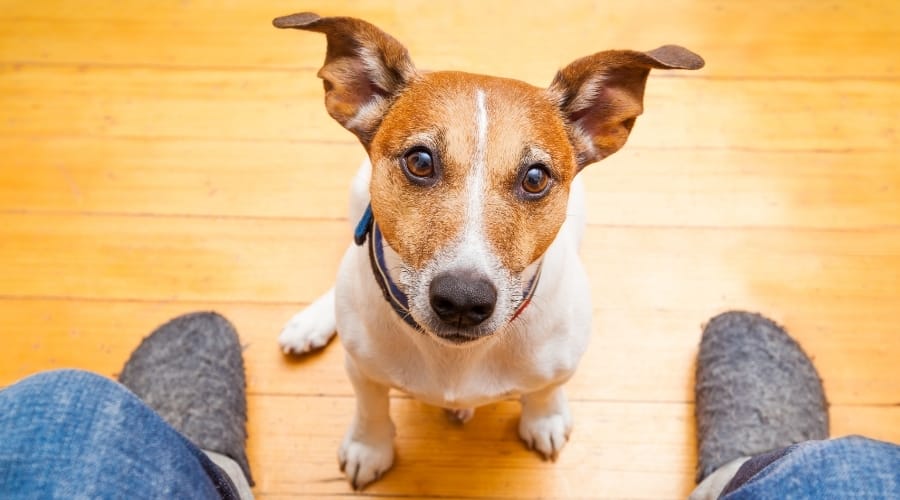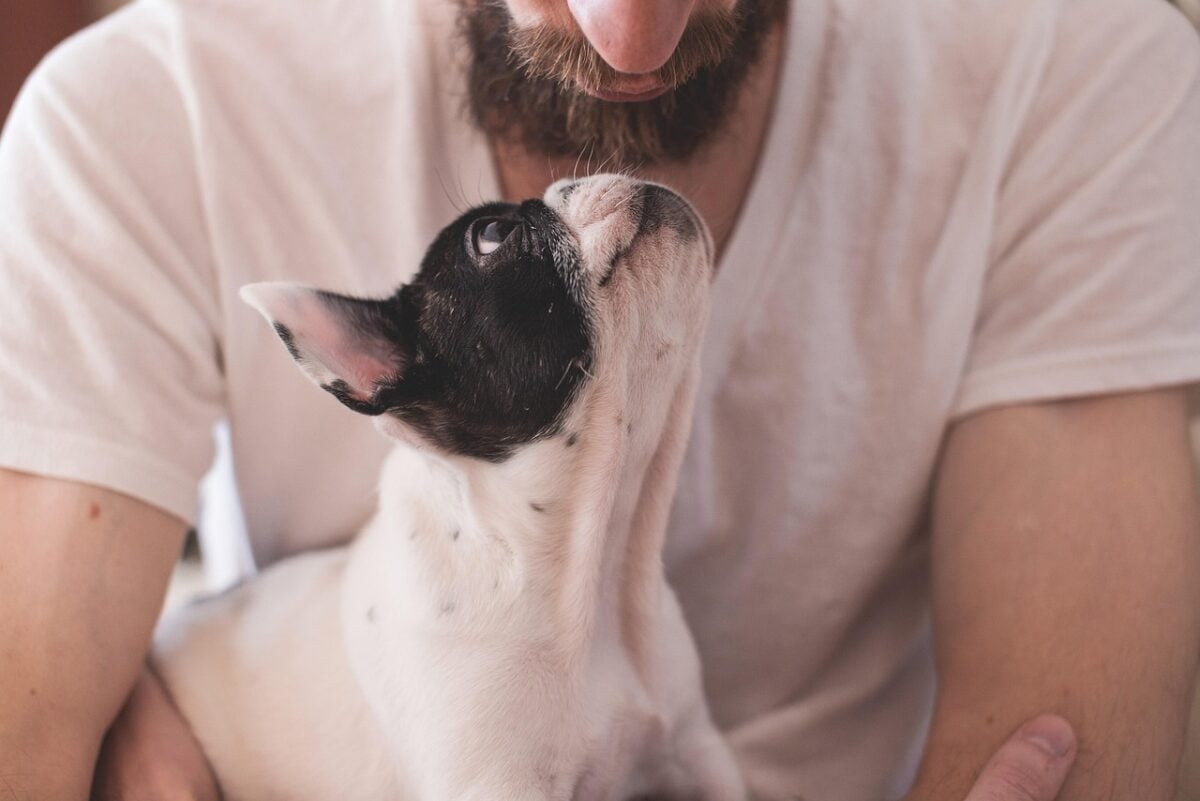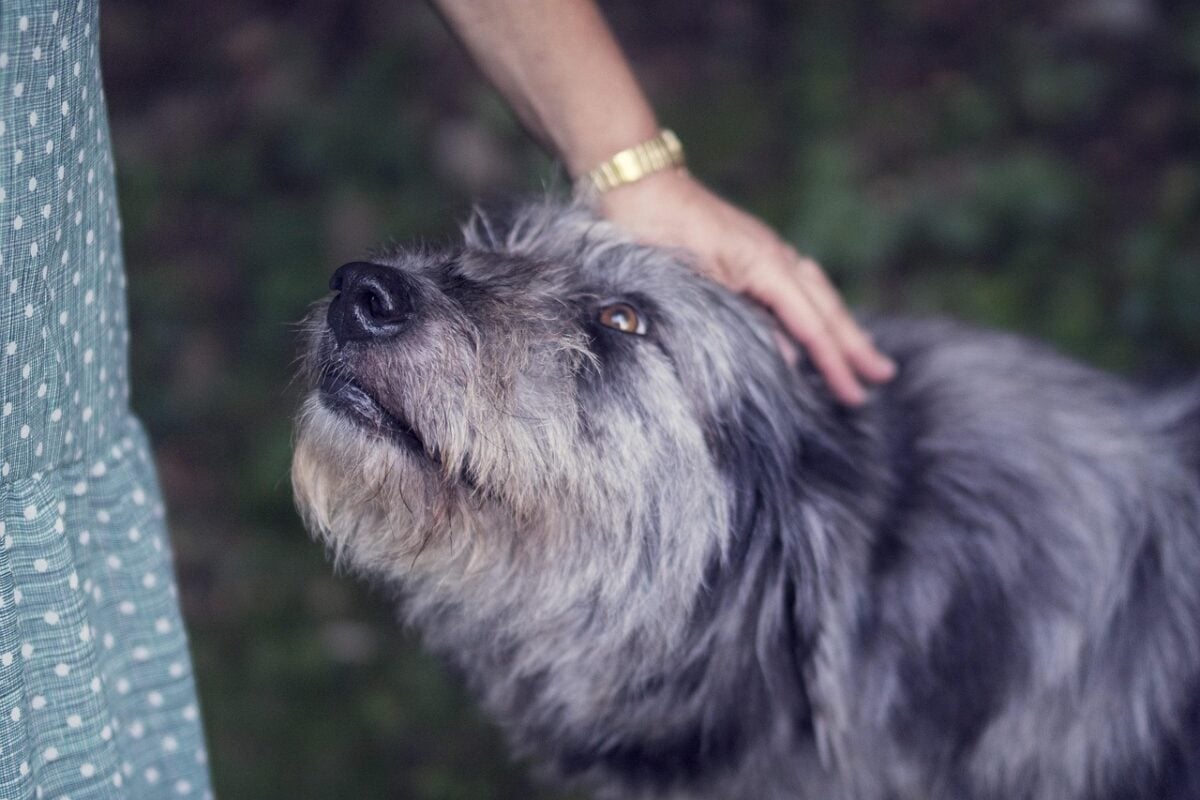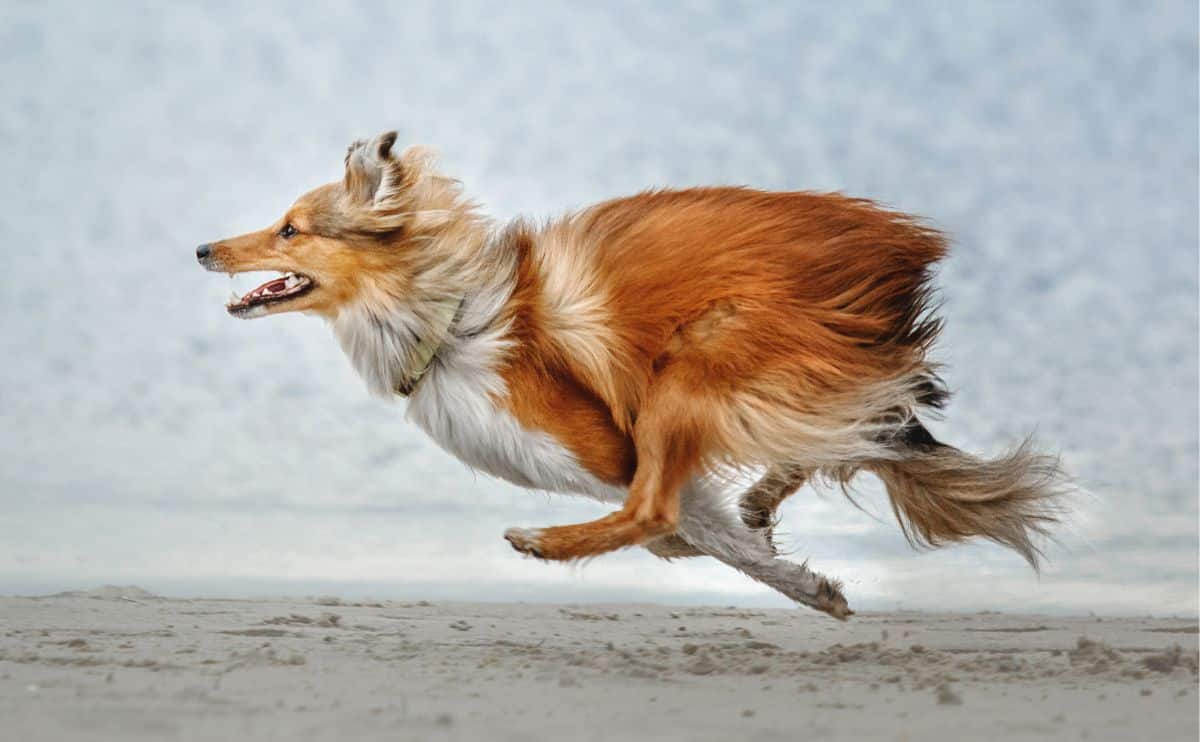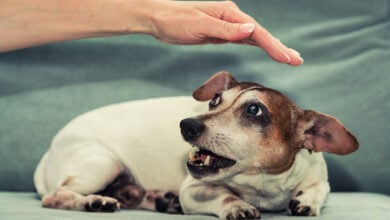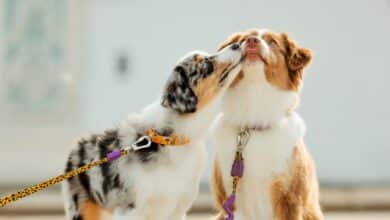Why Does My Dog Stare At Me? (It’s Not Just For Treats)
When you purchase through links on our site, we may earn a commission. Here’s how it works.
You feel it before you see it — that unmistakable weight of canine attention. You glance up, and there it is: your dog, motionless, studying you with the quiet focus of someone who knows exactly where the treats are hidden.
Table of Contents
If you’ve ever asked, “Why does my dog stare at me all the time?” you’re in good company. That steady gaze is one of the most recognizable — and misunderstood — behaviors in the dog world. To humans, staring feels intimate, sometimes even invasive. To dogs, it’s simply communication.
A Brief History Of The Dog-Human Gaze
Long before dogs became our alarm clocks and dinner witnesses, their ancestors were watching us from a distance and silently learning.
Early wolves that lingered near human campsites discovered a survival advantage: those who paid attention to human movements found more food and faced less conflict. Over generations, the boldest watchers evolved into our first domesticated dogs — animals uniquely tuned to human behavior.
Centuries later, that same behavior still drives your dog’s habit of staring at you across the living room.

Modern science helps explain how deep this bond runs. Researchers at the Yale Canine Cognition Center found that domestication sharpened dogs’ ability to follow human gaze — a skill even closely related wolves rarely master. In their experiments, dogs easily used human eye direction to locate hidden food, while wolves raised with people struggled. The takeaway: dogs didn’t just learn to look at us; they evolved to think with us.
In essence, eye contact became a kind of shared language. What once signaled danger between predator and prey turned into a cooperative signal — a way to coordinate, anticipate, and connect.
So when your dog studies your every move, they’re not being nosy. They’re doing what millennia of partnership taught them to do: watch closely, understand quickly, and act accordingly.
Did You Know?
Dogs are one of the few species proven to make consistent, prolonged eye contact with humans voluntarily. Even human-raised wolves avoid direct gaze — a key clue in how dogs evolved to read us so well.
Why Does My Dog Always Stare At Me?
A dog’s stare is a surprisingly nuanced thing. It can feel like affection, interrogation, or something in between.
To them, though, it’s simple. Staring is how they communicate, interpret, and occasionally influence the humans they share space with. Here are the most common reasons your dog watches you so intently and what each one actually says.
1. They’re Showing Affection
Sometimes your dog stares at you for the same reason you can’t stop looking at them: love, plain and simple, just with much less subtlety.
When dogs and humans lock eyes, something remarkable happens. A 2015 study found that mutual gazes between dogs and humans trigger a release of oxytocin, the “bonding hormone” that cements emotional connection. It’s the same chemical loop that makes parents fall in love with their newborns.
So when your dog gazes into your face, it’s biology at work. A loving stare is easy to spot — relaxed eyelids, gentle expression, loose body language. No tension or agenda. Just a pure connection.
2. They’re Reading Your Emotions
Dogs are professional mood readers. You don’t need to say a word because they’ve already noted your posture, tone, and whether your sighs sound like existential dread or mild irritation.
Research published in The Royal Society’s Biology Letters journal found that dogs can combine visual and auditory cues to recognize human emotions. In other words, they don’t just see your frown — they match it to your tone of voice and body tension to figure out how you feel.
- If you’re happy, their tail wags.
- If you’re stressed, their ears droop.
- If you’re angry, they watch you carefully — not out of fear, but out of “I’ll wait until this passes.”
It’s empathy wrapped in instinct. Thousands of years of domestication taught dogs that reading us correctly could mean safety, food, or affection. It’s a survival skill turned superpower.
They’re not judging your emotional rollercoaster; they’re riding in the front seat with you. That’s why your dog hovers when you’re crying, or stares intently when you’re tense.
3. Curiosity: The Canine Way Of Saying “What Are You Doing?”
Dogs are, at heart, professional observers. They watch everything: your routine, your tone, the way you reach for your shoes versus your car keys. To them, you’re the world’s most interesting documentary.
Curiosity drives much of that steady gaze. Dogs are hardwired to notice movement and pattern; that’s how their ancestors stayed alive. These days, the stakes are lower, but the fascination remains.
A curious stare is easy to spot: soft eyes, perked ears, a little head tilt.
If it ever feels too intense, offer them direction, such as a quick “sit,” a toy, or a training cue. It channels that curiosity into something productive, and keeps them from developing more creative hobbies (like counter-surfing).
Fun Fact
To your dog, you’re the world’s longest-running reality show. Studies show dogs track our micro-movements and even subtle shifts in body position to predict what happens next.
4. Communicating Wants Or Needs
Dogs have mastered an ancient art form: getting what they want without saying a word. The stare is their language — equal parts request, negotiation, and polite ultimatum.
Centuries of cohabitation have taught dogs that humans respond better to eye contact than barking. A single, deliberate look can open doors (literally), refill bowls, or end a Zoom call early.
Common variations include:
- The Food Stare: pupils slightly wider, posture alert. You’re preparing food, and they’re studying every wrist movement like a surgeon.
- The Affection Stare: soft eyes, loose body, often paired with a sigh. The canine equivalent of tapping your shoulder.
- The Play Stare: ears forward, tail sweeping the floor. “You seem under-stimulated. I can fix that.”
- The Need To Go Potty Stare: intense and brief. The message is urgent and non-negotiable.
Behavioral experts believe that dogs frequently pair staring with directional cues, such as a glance toward the leash, toy, or door, to clarify the request. It’s a sophisticated form of pointing without fingers.
Responding consistently strengthens trust; ignoring it teaches confusion. And if you misread the “feed me” look as “let’s snuggle,” don’t worry. They’ll clarify, probably by staring harder.
5. The Pooping Stare
It’s the moment every dog owner knows: your pet locks eyes with you mid-squat, as if seeking moral support during a private ordeal. You look away; they don’t. There’s a reason.
When dogs relieve themselves, they’re physically compromised — a leftover instinct from life in the wild. Maintaining eye contact is a survival protocol. They’re checking to be sure you’re still on lookout duty while they’re indisposed.

There’s even some scientific quirk to their focus. Research in Frontiers in Zoology found that dogs often align their bodies with Earth’s magnetic field when eliminating. So that long, concentrated look isn’t drama — it’s orientation. Planetary and emotional.
6. Anxiety Or Discomfort
Not every stare is affectionate or curious. Sometimes, it’s anxiety wearing a polite expression.
When dogs feel uneasy with a loud noise, a stranger, or an unfamiliar environment, they often look to their owners for guidance. It’s called social referencing: the instinct to check your reaction before deciding whether something is safe.

Veterinary behaviorists note that anxious dogs may hold eye contact longer than usual, hoping for reassurance. The stare may be paired with other cues — a tucked tail, lowered body, or licking lips.
A calm tone, steady posture, and soft eye contact can help. Responding with patience tells your dog that whatever’s happening is manageable. Reacting with tension, even unintentional, can confirm their fears.
If anxiety-driven staring becomes constant, it may signal chronic stress or underlying discomfort from an underlying medical problem. , from joint pain to separation anxiety. A veterinary checkup and consistent routine often help more than verbal comfort alone.
7. Aggression
The “hard stare” is the one every owner needs to recognize. Unlike the soft, loving gaze that melts your heart, this look is rigid, still, and loaded with intent.
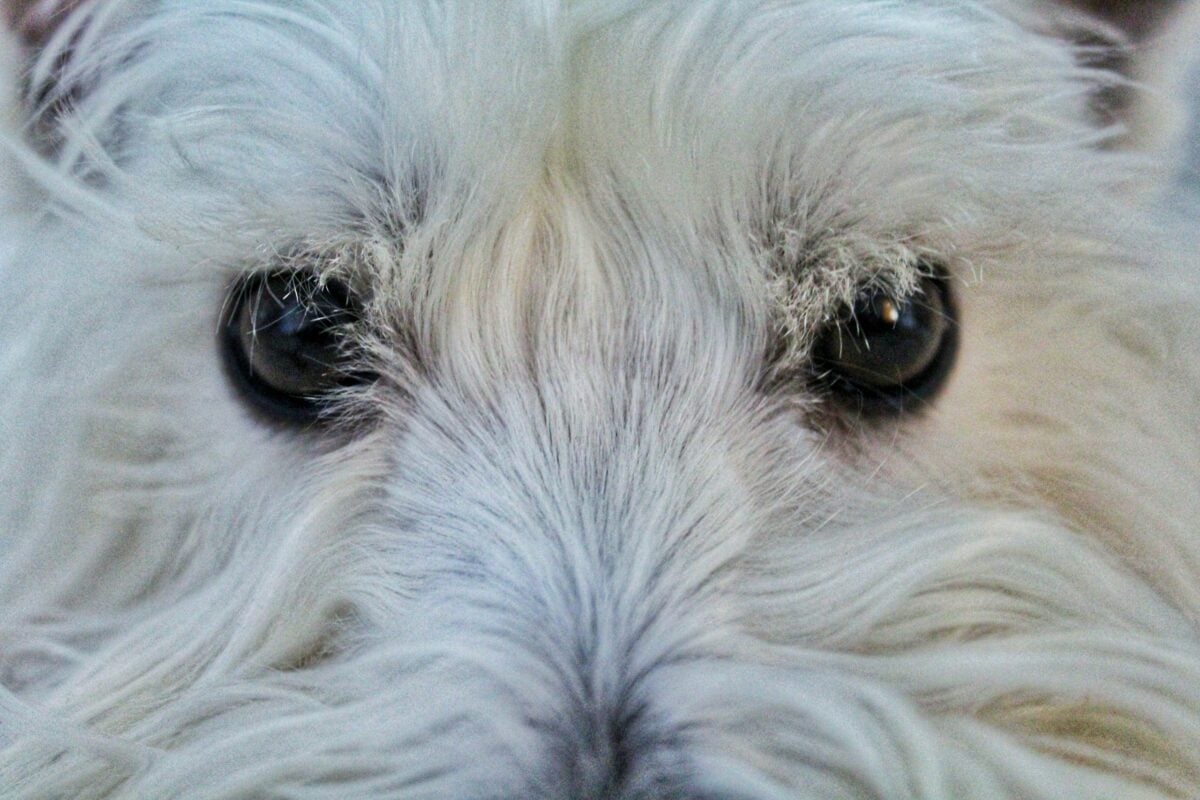
Dogs use prolonged, unblinking eye contact as a warning signal — a clear message to back off. The body tells the rest of the story: stiff posture, forward weight, lips tight or slightly curled. The ASPCA and other experts stress that this is not “bad behavior,” but communication, the canine equivalent of “Don’t push it.”
Punishing or matching that energy only increases risk. The right move is to de-escalate by creating space, avoiding direct eye contact, and letting the dog reset.
If it happens often, consult a certified behaviorist to help identify what’s provoking the aggressive response.
8. Cognitive Dysfunction
If your senior dog stares at you (or at walls, doors, or nothing at all), it may not be communication. It could be confusion.
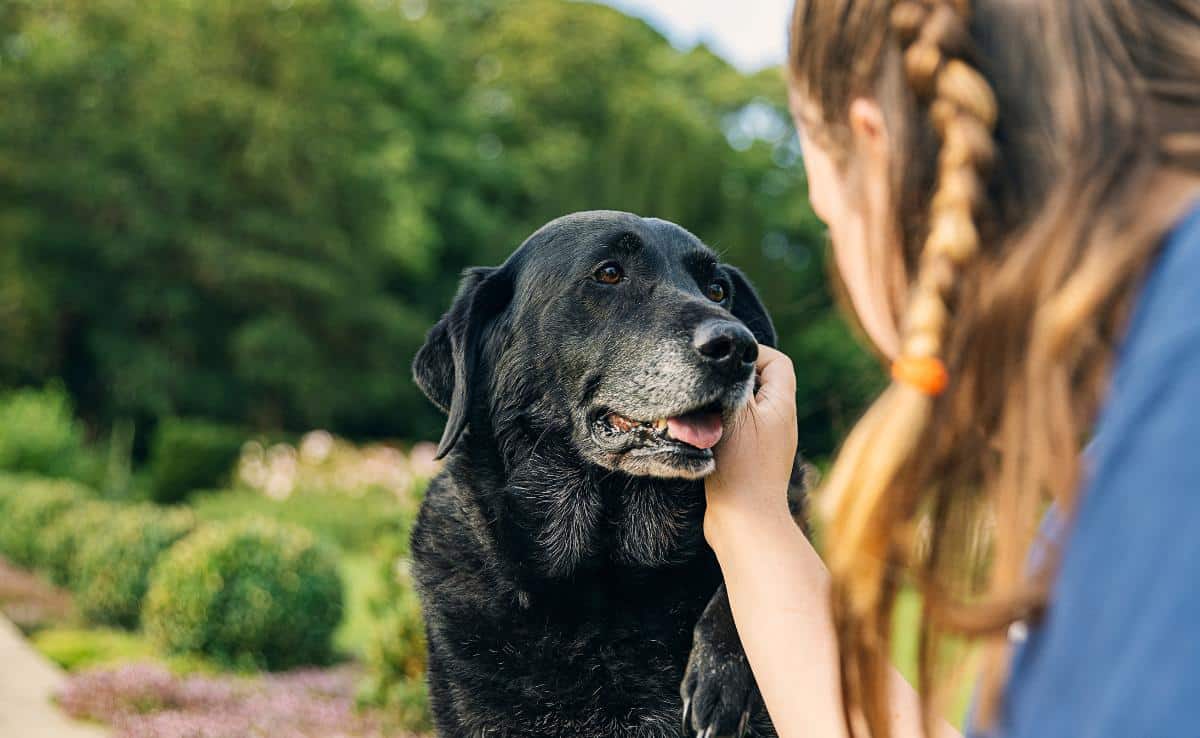
Canine cognitive dysfunction (CCD) is similar to dementia in humans. It affects memory, perception, and sleep-wake cycles. Dogs may appear lost in familiar spaces or fixate on their owners as if trying to remember what they were about to do. Symptoms, such as staring into space, pacing, or suddenly seeming disconnected, often emerge gradually.
A veterinary exam can rule out pain, vision issues, or neurological disease. If CCD is the cause, a change in diet to a high-quality senior dog food, supplements like omega-3s, environmental enrichment, mental games, and structured routines can help slow progression and improve comfort.
In these moments, the best response is patience. Your dog may not always know who or what they’re looking at, but they still know you make them feel safe.
How To Figure Out Why Your Dog Is Staring At You
Context is key. By considering what you’re doing and when you’re doing it, you can probably figure out what your dog is trying to communicate with their big, expressive eyes.

Dogs rarely do anything without a reason. The trick is understanding what kind of stare you’re getting and what it means in context. Here’s how to read the room.
1. Notice When It Happens
Patterns reveal purpose. If the stare happens before dinner, it’s probably anticipation. During a walk, focus. While you’re sad, comfort. Keeping a small mental log of when and how it occurs can turn mystery into routine.
2. Read The Rest Of The Dog
Eyes tell half the story. The rest lies in your pup’s posture, ears, and tail.
- Soft body, wagging tail, relaxed face: affection or curiosity.
- Stiff body, forward stance, still tail: tension or guarding.
- Low body, tucked tail, avoiding contact: stress or discomfort.
Be sure to check out our comprehensive guide on dog body language to learn how to decipher your dog’s communication cues.
3. Check Your Own Energy
Dogs mirror us more than we realize. Your mood, tone, and posture often determine how they behave. If you’re tense, they’ll look for clues; if you’re calm, they’ll relax. In a way, that stare is feedback — a silent audit of your emotional leadership.

Our Personal Experience With A Starer
Once you start paying attention, you realize how consistent these cues are. As my colleague Danielle shares…
I often feel like I am being watched, because I am.
My dog Falkor, a 4-year-old Poodle-Beagle mix with the soul of a philosopher and the focus of a stalker, spends most of his day staring at me. He doesn’t just glance my way; he studies me like I’m a live-action nature documentary titled “Human at Work: The Snack Dispenser Chronicles.”
If he’s on my lap, he tilts his head and gazes up like he’s decoding the mysteries of the universe (or possibly debating if sitting closer might yield more belly rubs). Even when he’s across the room, cozied up with my daughter on the couch, his eyes stay locked on me, wide, unblinking, devoted.
And when our eyes finally meet, it feels almost spiritual, like he’s peering straight into my soul… and silently whispering, “You know what would make this connection even deeper? A treat.”
– Danielle DeGroot, Rescue Dog Mom, Writer For Canine Journal
I can’t say I mind my devoted little shadow. Honestly, being stared at like I’m the sun and he’s a planet in perfect orbit? It’s kind of flattering. Who wouldn’t love that kind of unconditional adoration?
Types Of Stares
Dogs have an impressive range of looks, from “I adore you” to “Step away from my chew toy.” Learning to tell them apart is part science, part intuition, and a lot of paying attention.
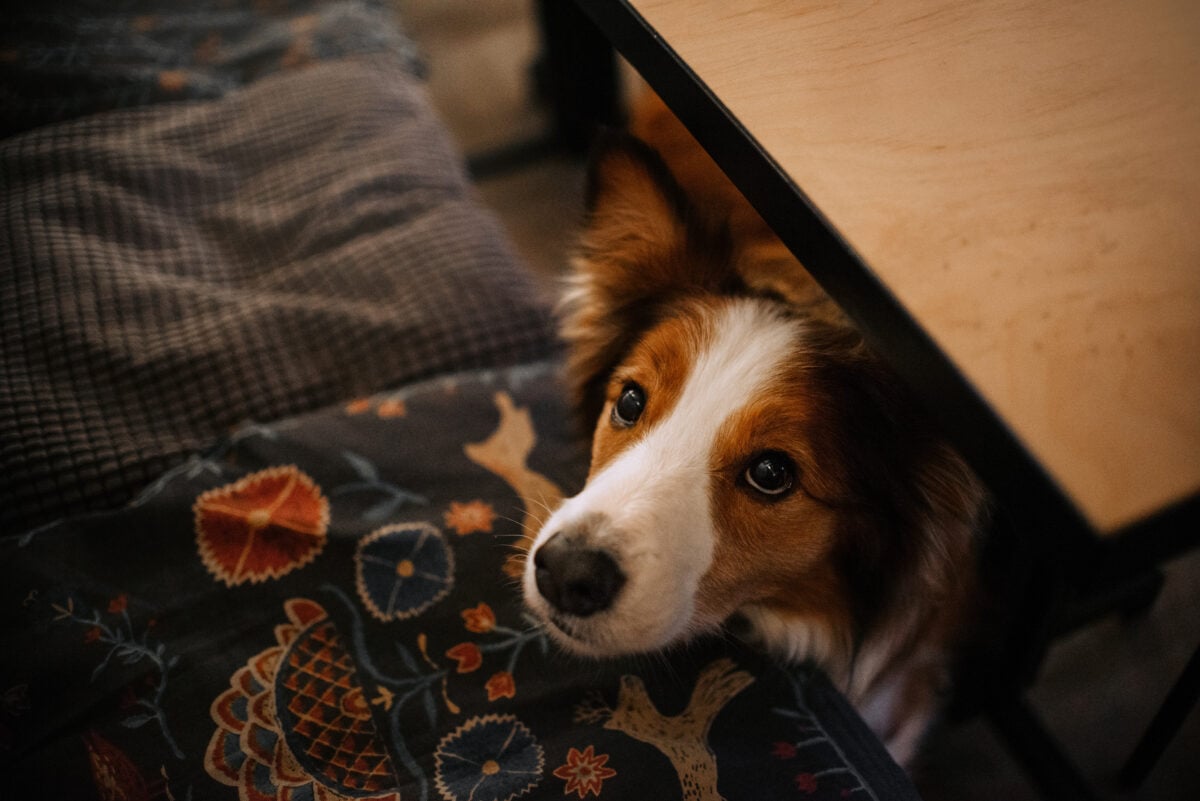
The Soft Stare
Gentle, steady, and often paired with relaxed ears and a loose mouth. This is the canine version of eye contact over coffee — intimate but comfortable. It usually signals affection, calm attention, or simple curiosity. The gaze lingers, but never feels tense.
Translation: “I like being near you, and I’m checking in.”
The Expectant Stare
Slightly more alert, sometimes with raised brows or a quick glance toward the treat jar, leash, or door. The eyes are bright, the energy focused. This stare says your dog is ready for action — or at least hoping for snacks.
Translation: “I know that sound. It usually ends well for me.”
The Hard Stare
Rigid, unblinking, and accompanied by a still body or forward stance. This one is about control or protection, not affection. It’s often seen when a dog feels cornered, uncertain, or guarding something of value.
Certified behaviorists describe this look as a prelude to aggression — a warning, not a threat. Recognizing it early helps prevent escalation and builds trust over time.
Translation: “I need space — right now.”
The Searching Stare
Common in senior dogs or those with anxiety. The eyes wander or fixate vaguely on you, a wall, or an empty space. It’s not focus; it’s disorientation. Often linked to aging or stress, it can signal cognitive decline or sensory loss.
Translation: “I’m trying to remember what I came in here for.”
What Your Dog’s Stare Says About You
Every stare tells a story, but sometimes, it’s yours. Dogs are expert observers, and over time, they tailor their behavior to the people they live with. That means how your dog looks at you can reveal more about your habits than theirs.
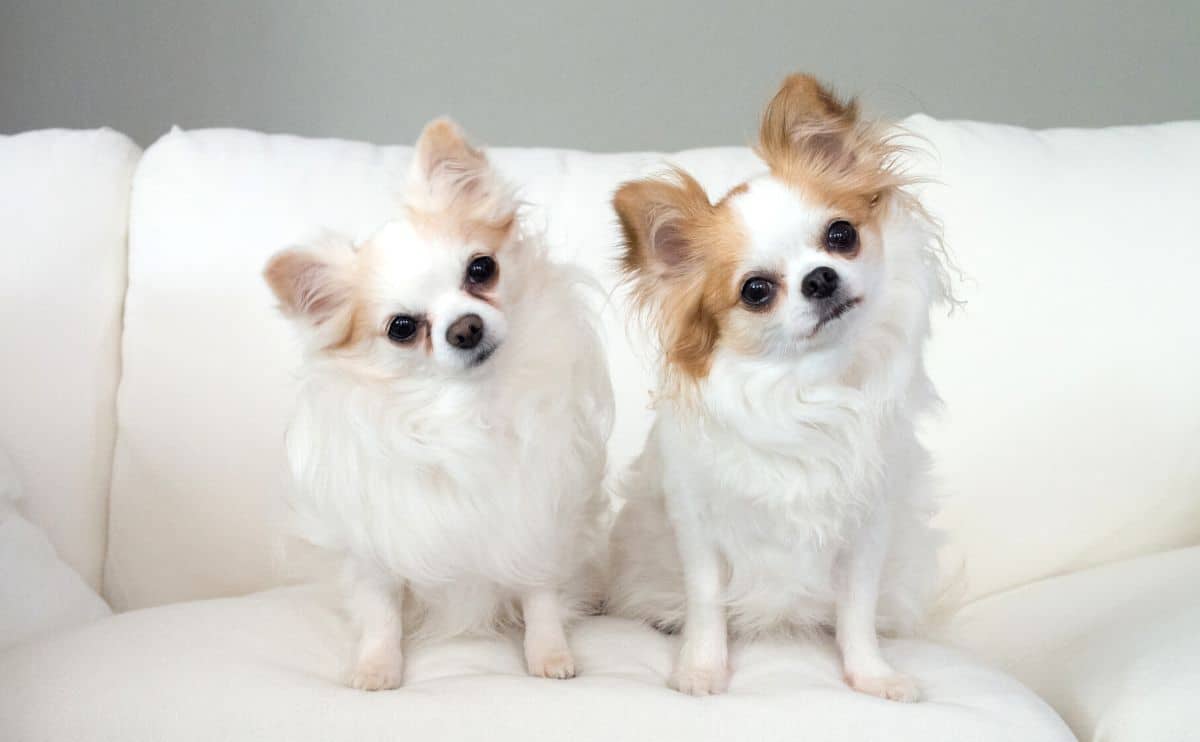
- The Planner’s Dog: Predictable schedule, consistent cues. Your dog doesn’t stare much — they already know what’s next.
- The Multitasker’s Dog: Watches every move because you’re unpredictable. Keys? Leash? Snack? It could go either way.
- The Empath’s Dog: Sensitive, watchful, and quick to mirror your emotions. Your stress becomes their homework.
- The Entertainer’s Dog: Thrives on feedback. They stare because the audience (you) always responds.
In a way, your dog’s stare is a progress report on your communication skills. The clearer your signals, the calmer their eyes.
How To Respond To A Staring Dog
How you respond to a dog’s stare matters as much as why they’re doing it. Eye contact is a dialogue — one that can build trust or, occasionally, misfire entirely. The goal isn’t to avoid their gaze, but to meet it with the right kind of energy.
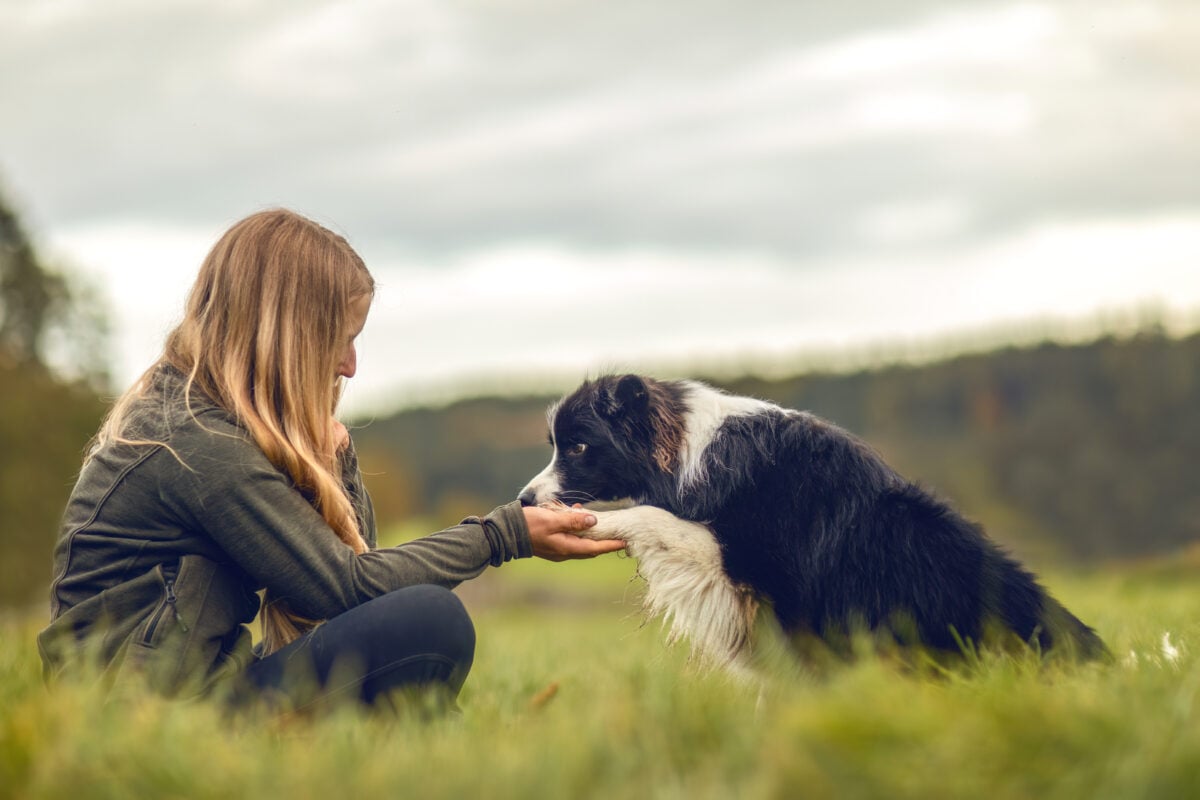
If It’s Affectionate
Enjoy it. Soft, relaxed eye contact strengthens your bond and actually releases oxytocin for both of you. A gentle look back, a calm tone, or a scratch behind the ears is all that’s needed. You don’t have to say “I love you.” Your eyes already did.
If It’s Expectant
Acknowledge the communication, then decide what it deserves. If your dog stares before every treat or meal, establish boundaries. Feed or play on schedule rather than on demand — it reinforces structure instead of begging. A predictable routine keeps affection from turning into manipulation (and prevents canine lobbyists from learning how to control you).
If It’s Anxious
Soften your gaze, speak slowly, and avoid sudden movements. Your calm energy becomes their anchor.
If the anxious staring happens often, consider environmental triggers, such as new people, noises, or inconsistencies in routine. Tools like calming treats, pheromone calming collars, or professional behavioral therapy can help both of you breathe easier.
If It’s Aggressive
Don’t match intensity. Staring back or raising your voice confirms the tension. Instead, create space and calmly redirect your pup’s focus. If this becomes a pattern, bring in a certified trainer or veterinary behaviorist.
If It’s Confused Or Disoriented
Comfort matters more than correction for senior dogs or those showing signs of cognitive dysfunction. Keep eye contact soft and brief, speak gently, and maintain predictable routines. Sometimes that blank look isn’t directed at you; it’s simply looking through you. Meet it with patience.
Can You Train Eye Contact?
Yes, and you should. Intentional eye contact training teaches dogs to focus calmly, not just stare hopefully. It’s one of the simplest ways to improve communication and reduce anxiety during walks, greetings, or distractions.

Trainers often use a “watch me” cue: hold a treat near your eyes, reward the glance, repeat. Over time, your dog learns that looking at you brings clarity and comfort.
This technique works especially well for reactive or nervous dogs. Redirecting their focus replaces uncertainty with connection — a kind of behavioral reset button.
Eye contact isn’t about control; it’s about cooperation. When your dog looks to you for direction, they’re choosing partnership over guesswork.
Trainer’s Tip: The 3-Second Rule
When teaching eye contact, the goal is brief and rewarding, rather than a staring contest.
Hold your dog’s gaze for no more than three seconds, then praise or treat. That short window keeps the interaction positive and prevents it from turning into a challenge.
Over time, those calm three-second check-ins become your dog’s favorite way of saying, “I’m listening.”
If you’d like professional guidance, our recommended online dog training programs include modules on attention-building and calm communication you can practice at home.
Does Dog Staring Ever Require Vet Attention?
Most of the time, your dog’s stare is harmless, but occasionally, it’s worth asking whether something deeper is going on.

Here’s when to take that look a little more seriously:
1. The Stare Feels “Off”
If your dog’s gaze seems unfocused, confused, or paired with pacing, circling, or “zoning out,” it may indicate cognitive decline, vision loss, or a neurological issue.
Senior dogs, in particular, are prone to canine cognitive dysfunction (CCD) — a condition similar to dementia in humans. A vet exam and bloodwork can help rule out other causes like thyroid imbalance or pain.
2. The Stare Comes With Aggression
A fixed, rigid stare combined with stiffness, growling, or lip curling means your dog feels threatened or protective. Don’t correct or challenge it; de-escalate and call a professional. Certified trainers or veterinary behaviorists can help you identify triggers and prevent escalation before it becomes a safety issue.
3. The Stare Signals Discomfort Or Pain
If your dog suddenly starts watching you more intensely, especially when touched or after activity, it may be a pain cue rather than a behavioral one. Dogs often seek guidance or reassurance when something hurts. A quick vet visit is always safer than waiting it out.
Rule of thumb: When the stare feels different — longer, vacant, or paired with new behaviors — don’t overanalyze. Observe, record, and call your vet. They can read the medical side of what your dog’s been trying to tell you.
Frequently Asked Questions
Here are some of the most common questions we see from owners about their dogs’ staring. If you don’t see yours here, ask us in our comments!
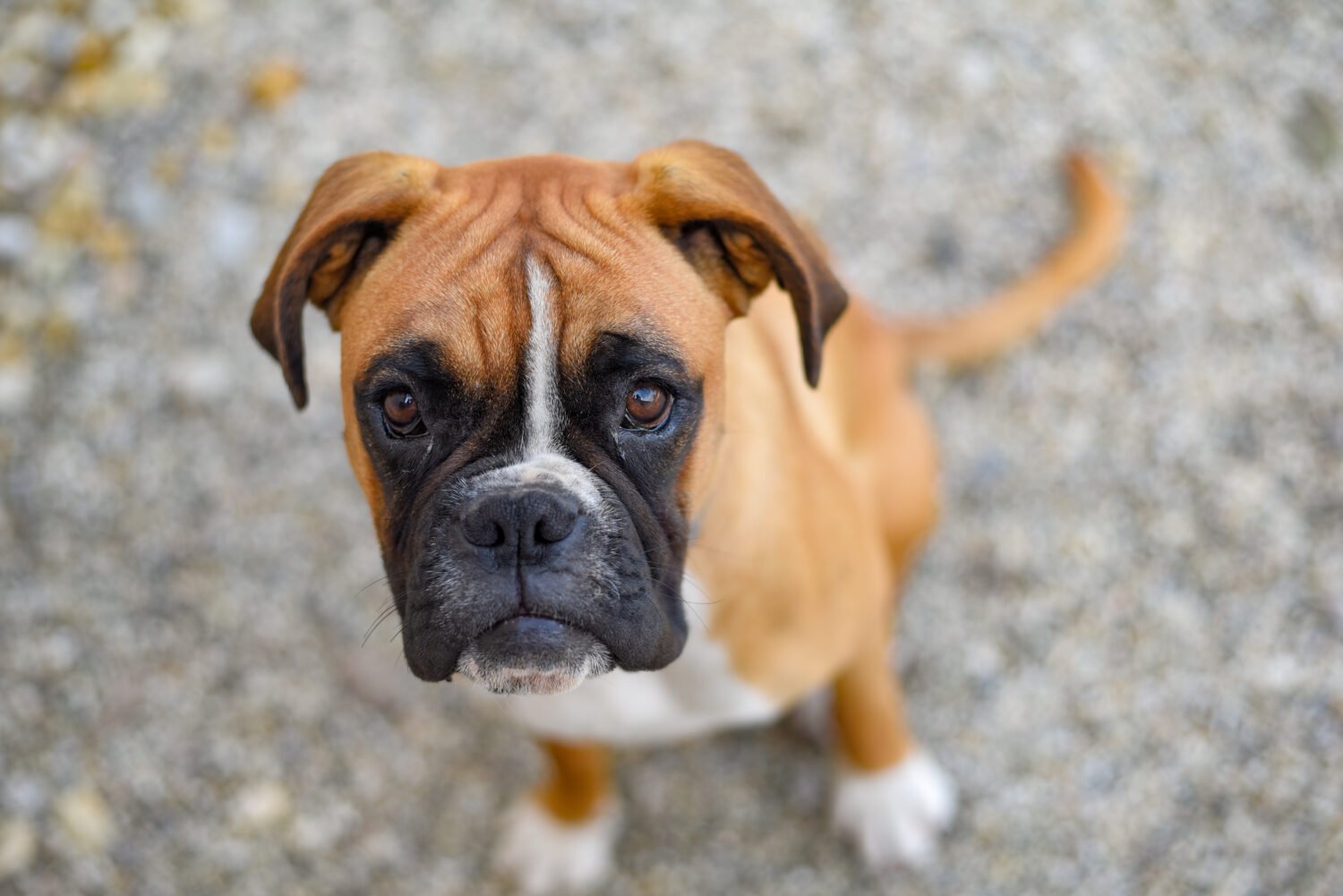
Why Does My Dog Stare At Me While I Eat?
They’re optimists. Centuries of evolution taught dogs that food sometimes falls, and humans are easily manipulated by soulful eyes. This is learned opportunism, not hunger — a polite form of begging dressed up as affection.
Why Does My Dog Stare At Me From Across The Room?
It depends on the context. A soft, relaxed gaze likely means “I’m content.” A fixed, still stare may suggest guarding or unease. Or they may simply be lost in thought — the canine version of staring into space.
My Senior Dog Stares At Walls. Should I Worry?
Probably. “Wall-staring” can indicate cognitive dysfunction, sensory decline, or neurological issues. It’s worth a vet visit, especially if it’s new or accompanied by pacing, circling, or nighttime restlessness.
Should I Stare Back At My Dog?
If the look feels soft and friendly, yes. A gentle gaze can strengthen your bond. But never force eye contact with a nervous or reactive dog. Mutual trust can’t be commanded; it’s earned over a thousand small, quiet looks.
Curious About Other Quirky Canine Behavior?
Our pups are fascinating creatures with some very odd, albeit normal, behaviors. If you’ve always wondered what makes them tick, check out our guides on quirky dog behavior:
- Why do dogs stretch when they see you?
- Deciphering tail wags
- Why do dogs tilt their heads?
- Understanding dog sniffing
Does your pup have a signature stare? Share your stories in our comments!
